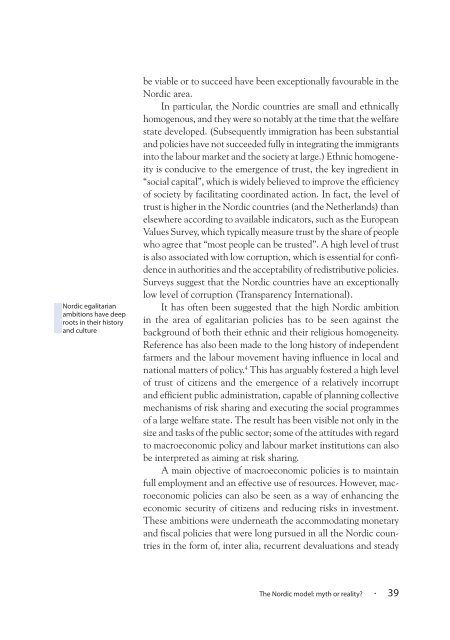The Nordic Model - Embracing globalization and sharing risks
The Nordic Model - Embracing globalization and sharing risks
The Nordic Model - Embracing globalization and sharing risks
You also want an ePaper? Increase the reach of your titles
YUMPU automatically turns print PDFs into web optimized ePapers that Google loves.
<strong>Nordic</strong> egalitarian<br />
ambitions have deep<br />
roots in their history<br />
<strong>and</strong> culture<br />
be viable or to succeed have been exceptionally favourable in the<br />
<strong>Nordic</strong> area.<br />
In particular, the <strong>Nordic</strong> countries are small <strong>and</strong> ethnically<br />
homogenous, <strong>and</strong> they were so notably at the time that the welfare<br />
state developed. (Subsequently immigration has been substantial<br />
<strong>and</strong> policies have not succeeded fully in integrating the immigrants<br />
into the labour market <strong>and</strong> the society at large.) Ethnic homogeneity<br />
is conducive to the emergence of trust, the key ingredient in<br />
“social capital”, which is widely believed to improve the efficiency<br />
of society by facilitating coordinated action. In fact, the level of<br />
trust is higher in the <strong>Nordic</strong> countries (<strong>and</strong> the Netherl<strong>and</strong>s) than<br />
elsewhere according to available indicators, such as the European<br />
Values Survey, which typically measure trust by the share of people<br />
who agree that “most people can be trusted”. A high level of trust<br />
is also associated with low corruption, which is essential for confidence<br />
in authorities <strong>and</strong> the acceptability of redistributive policies.<br />
Surveys suggest that the <strong>Nordic</strong> countries have an exceptionally<br />
low level of corruption (Transparency International).<br />
It has often been suggested that the high <strong>Nordic</strong> ambition<br />
in the area of egalitarian policies has to be seen against the<br />
background of both their ethnic <strong>and</strong> their religious homogeneity.<br />
Reference has also been made to the long history of independent<br />
farmers <strong>and</strong> the labour movement having influence in local <strong>and</strong><br />
national matters of policy. 4 This has arguably fostered a high level<br />
of trust of citizens <strong>and</strong> the emergence of a relatively incorrupt<br />
<strong>and</strong> efficient public administration, capable of planning collective<br />
mechanisms of risk <strong>sharing</strong> <strong>and</strong> executing the social programmes<br />
of a large welfare state. <strong>The</strong> result has been visible not only in the<br />
size <strong>and</strong> tasks of the public sector; some of the attitudes with regard<br />
to macroeconomic policy <strong>and</strong> labour market institutions can also<br />
be interpreted as aiming at risk <strong>sharing</strong>.<br />
A main objective of macroeconomic policies is to maintain<br />
full employment <strong>and</strong> an effective use of resources. However, macroeconomic<br />
policies can also be seen as a way of enhancing the<br />
economic security of citizens <strong>and</strong> reducing <strong>risks</strong> in investment.<br />
<strong>The</strong>se ambitions were underneath the accommodating monetary<br />
<strong>and</strong> fiscal policies that were long pursued in all the <strong>Nordic</strong> countries<br />
in the form of, inter alia, recurrent devaluations <strong>and</strong> steady<br />
<strong>The</strong> <strong>Nordic</strong> model: myth or reality? · 39

















